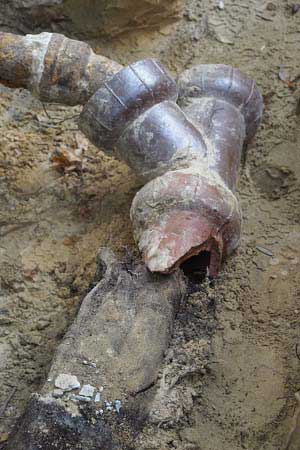
Water under a concrete slab foundation is a bad situation because it can cause one or more problems including soil erosion under the slab, compaction of soil under the slab, swelling of the clay soils (uplift) under the slab, and other types of soil movement that can cause damage to drain lines and the slab foundation of the home. The first two problems mentioned above, soil erosion and compaction, will result in a void or the separation of the soil from the bottom of the slab foundation. If this void becomes too large then part of the slab foundation is at risk of cracking and collapsing (settlement). When this happens a part of the concrete slab foundation will collapse until it reaches support, or the remaining or compacted soil below. Settlement can easily break drain and sewer lines under the slab foundation.
Buildings and homes in geographic areas with clay soils are susceptible to soil movement and this soil movement can be the cause of broken drain pipes and water leaks under slab foundations. Several inches of soil movement can easily break rigid sewer and drain lines. In addition, older homes built before 1970 will likely have sewer and drain lines made of concrete or cast iron and their useful lives are only 50 to 60 years.
Foundation settlement and broken drain pipes under the concrete slab are often related problems. The concrete foundation and the under slab plumbing system should both be inspected if there is a problem with one of them. We are a unique company in that we have 30+ years experience in under slab plumbing repair and we can refer homeowners to a high quality foundation repair company. Compare us with other plumbing contractors.
Old Sewer Lines
Concrete Sewer Lines
Concrete Sewer Lines were frequently used in homes and other properties that were built before 1970. They were used under the slab foundation and from the foundation perimeter to the city’s main sewer line. The problem with concrete sewer lines is that they deteriorate over time and they begin to fail at 50 to 60 years of age. Today these older drain and sewer line systems are replaced with a modern, long-lived plastic piping called PVC. It is believed that PVC will last at least 100 years and perhaps 200 years.
Cast Iron Sewer Lines
Under slab and under cast iron sewer lines were often installed in homes built before 1970. The primary problem with cast iron drain lines is that they begin to corrode from the day of installation. The lifespan of a cast iron plumbing systems is about 50 to 60 years. At that point they begin to fail and collapse. Cast iron drain systems are usually replaced with modern PVC piping systems. PVC is a durable, heavy duty plastic with some flexibility. The lifespan of PVC is thought to be in excess of 100 years and may be double that number.
Water Leak Locations
Pier and Beam Foundations
Finding water leaks under a house on a pier and beam foundation is a relatively easy task when there is sufficient crawl space under the structure. A plumber can crawl under the structure, examine the drain line system, find the leak, and make any necessary plumbing repairs or replacements. Unless the crawl space is unusually narrow, there is no need to tunnel under the home. Since no tunneling is required in these situations, the broken drain lines under the house are fixed in a much shorter time frame. And since there is no cost to tunnel under a slab the final repair bill is lower.
Concrete Slab Foundations
The worst place to have a broken drain or sewer line is under a home’s concrete slab foundation. The reason is because access to the area is difficult. The two methods used to access water leaks under a slab foundation are 1) jackhammer an opening or channel from above, and 2) tunnel under the slab. We seldom utilize the jackhammer method because any extensive “breakout” of the slab can be difficult and requires significant flooring repair. We prefer to tunnel under a concrete slab foundation to access horizontal plumbing lines.
We will tunnel under a slab foundation to access the leak and the water drain pipes. It is manual labor and it is time consuming but the foundation is not compromised or damaged as it would be with the jackhammer method mentioned above.
Frequently an older drain line system will need to be completely replaced. If the building or home has an older concrete or cast iron drain line system then the property owner would be wiser to replace all of it with a PVC system with a 100+ year lifespan. So how do we access an entire drain line system for replacement? By trenching and tunneling.
Replacing The Drain Line System
Trenching
Trenching is perhaps the least difficult part of replacing a drain line system because the plumbers are working above ground and access is relatively easy. Trenching involves digging through two to eight feet of dirt to expose the existing drain lines between the building perimeter and the city’s main sewer line. The trenching is done either manually or with a small mechanized machine. The old drain lines are removed and replaced with new PVC drain lines. PVC is durable and has a long lifespan.
Tunneling
Tunneling is the most time consuming and expensive part of an under slab plumbing repair job. Our workers dig a 3 foot by 3 foot tunnel under a home’s slab foundation to access the areas that need repair or replacement. After the plumbing repairs or replacements have been made to the drain line system the soil is “packed” back into the tunnel. Every five or six feet we pump a slurry of concrete and mud into the tunnel to fill any voids.
Call us at 346-347-3500 for a Plumbing Inspection
